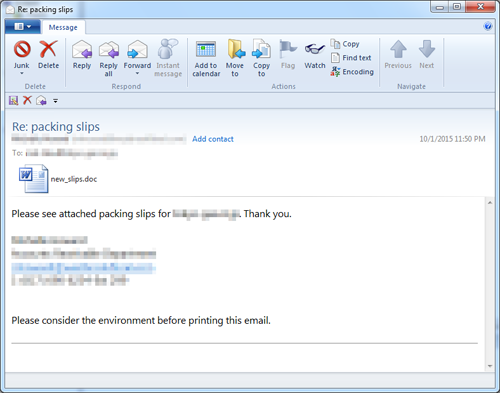W2KM_FAREIT.BK
TrojanDropper:O97M/Artitex.A (Microsoft); Troj/DocDl-ACO (Sophos); W97M/Dropper!305D5710ACB3 (McAfee); Trojan-PSW.Win32.Fareit.gsg (Kaspersky); VBA/TrojanDropper.Agent.DA (ESET-NOD32)
Windows


Threat Type: Trojan
Destructiveness: No
Encrypted: Yes
In the wild: Yes
OVERVIEW
This Trojan arrives as attachment to mass-mailed email messages.
It does not have any propagation routine.
It does not have any backdoor routine.
It executes the dropped file(s). As a result, malicious routines of the dropped files are exhibited on the affected system.
It does not have any information-stealing capability.
TECHNICAL DETAILS
Arrival Details
This Trojan arrives as attachment to mass-mailed email messages.
Installation
This Trojan drops and executes the following files:
- %User Temp%\199.rtf ← decoy file
- %User Temp%\200.rtf ← decoy file
(Note: %User Temp% is the user's temporary folder, where it usually is C:\Documents and Settings\{user name}\Local Settings\Temp on Windows 2000, Windows Server 2003, and Windows XP (32- and 64-bit); C:\Users\{user name}\AppData\Local\Temp on Windows Vista (32- and 64-bit), Windows 7 (32- and 64-bit), Windows 8 (32- and 64-bit), Windows 8.1 (32- and 64-bit), Windows Server 2008, and Windows Server 2012.)
Propagation
This Trojan does not have any propagation routine.
Backdoor Routine
This Trojan does not have any backdoor routine.
Dropping Routine
This Trojan drops the following files:
- %User Temp%\pa1.exe ← detected as TSPY_FAREIT.YYSNO
(Note: %User Temp% is the user's temporary folder, where it usually is C:\Documents and Settings\{user name}\Local Settings\Temp on Windows 2000, Windows Server 2003, and Windows XP (32- and 64-bit); C:\Users\{user name}\AppData\Local\Temp on Windows Vista (32- and 64-bit), Windows 7 (32- and 64-bit), Windows 8 (32- and 64-bit), Windows 8.1 (32- and 64-bit), Windows Server 2008, and Windows Server 2012.)
It executes the dropped file(s). As a result, malicious routines of the dropped files are exhibited on the affected system.
Information Theft
This Trojan does not have any information-stealing capability.
Other Details
This is the Trend Micro detection for Microsoft Word documents that are compromised through the insertion of a malicious macro.
NOTES:
It drops non-malicious .RTF file and opens it to deceive users into thinking it is a normal file while displaying the following error message:

Below is a sample of the said spam mail:

SOLUTION
Step 1
Before doing any scans, Windows XP, Windows Vista, and Windows 7 users must disable System Restore to allow full scanning of their computers.
Step 2
Note that not all files, folders, and registry keys and entries are installed on your computer during this malware's/spyware's/grayware's execution. This may be due to incomplete installation or other operating system conditions. If you do not find the same files/folders/registry information, please proceed to the next step.
Step 3
Remove the malware/grayware file dropped/downloaded by W2KM_FAREIT.BK. (Note: Please skip this step if the threat(s) listed below have already been removed.)
- TSPY_FAREIT.YYSNO
Step 4
Search and delete these files
- %User Temp%\199.rtf
- %User Temp%\200.rtf
Step 5
Enable the macro virus protection in Microsoft Office Applications
Step 6
Scan your computer with your Trend Micro product to delete files detected as W2KM_FAREIT.BK. If the detected files have already been cleaned, deleted, or quarantined by your Trend Micro product, no further step is required. You may opt to simply delete the quarantined files. Please check this Knowledge Base page for more information.
Did this description help? Tell us how we did.
